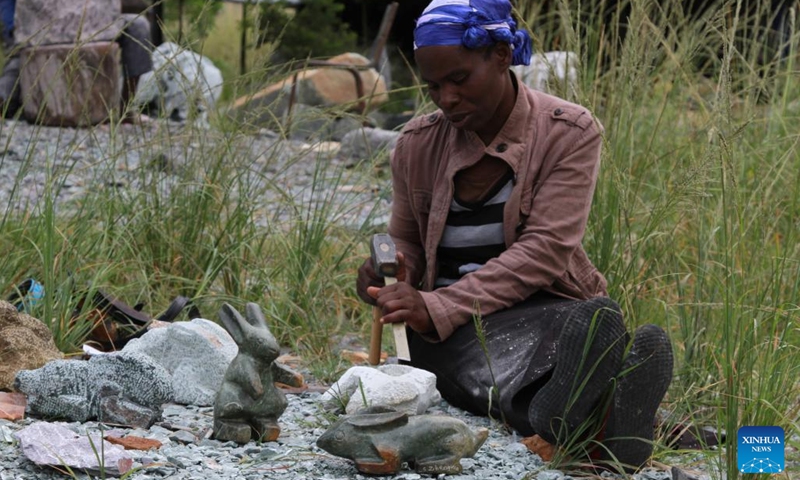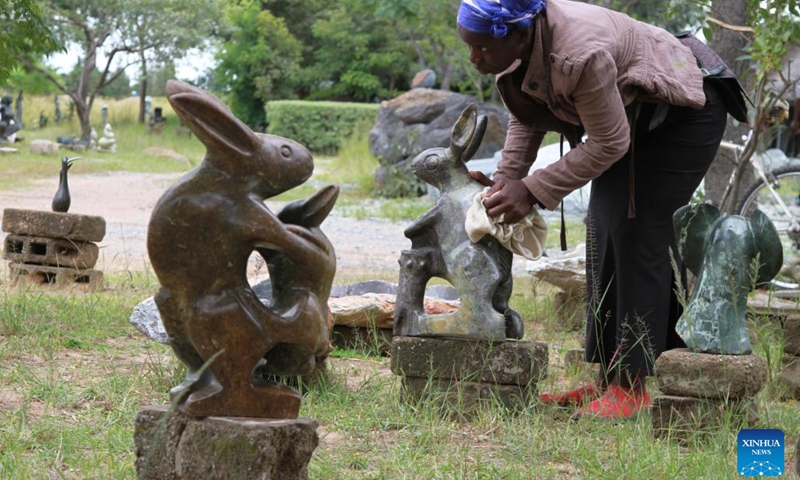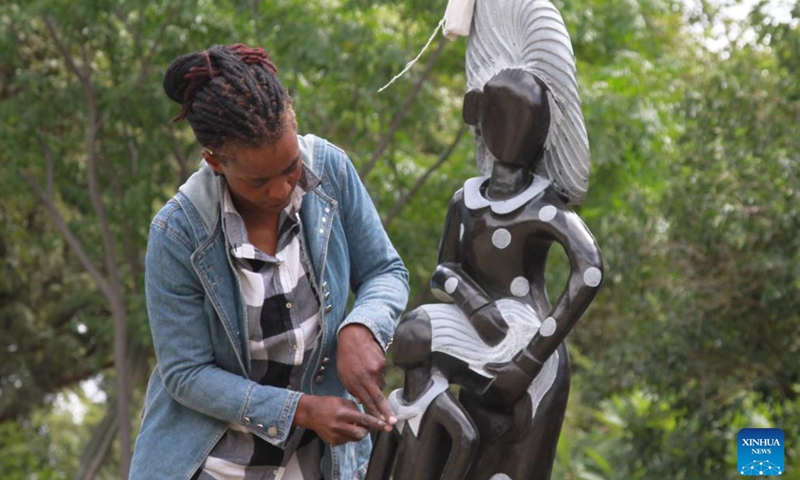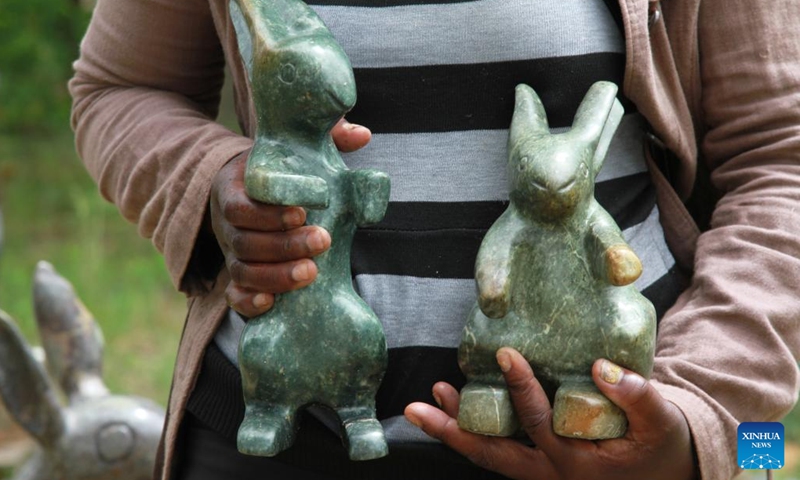
Simelokuhle Zibengwa, a stone sculptor at Chitungwiza Arts Center, works on a rock to make a sculpture in Chitungwiza, a town south of Harare, Zimbabwe, on March 17, 2022.(Photo: Xinhua)

Simelokuhle Zibengwa, a stone sculptor at Chitungwiza Arts Center, polishes her sculpture in Chitungwiza, a town south of Harare, Zimbabwe, on March 17, 2022.(Photo: Xinhua)

Lorraine Mamvura, an artist focusing on realistic art at Chitungwiza Arts Center, works on an artwork in Chitungwiza, a town south of Harare, Zimbabwe, on March 17, 2022.(Photo: Xinhua)

Lorraine Mamvura, an artist focusing on realistic art at Chitungwiza Arts Center, works on an artwork in Chitungwiza, a town south of Harare, Zimbabwe, on March 17, 2022.(Photo: Xinhua)
Firmly grasping a hammer and chisel, Simelokuhle Zibengwa, a stone sculptor, effortlessly pounded on a small chunk of rock.
White-ish fragments fell off as she carefully hammered through the stone.
After a while, and with a great deal of effort, a figure of a rabbit could be seen taking shape.
Zibengwa's works of art are not just a marvel to the onlooker, they narrate different tales through the use of stone-carved sculpture.
The renowned artist uses figurative art in the form of rabbits to tell stories of human life, particularly women's day-to-day struggles.
"The rabbits are not realistic wild rabbits. They are creative abstracts, and they describe human lives," Zibengwa told Xinhua.
She said by employing personified rabbits, her art aims to create art that provokes an emotional response to the onlooker.
One of Zimengwa's pieces depicts a rabbit playing an African drum. Another one shows a rabbit mother showing affection to her child.
"The trait of a rabbit that influenced my decision to do rabbit-themed art is how brave rabbits are portrayed in fairy tales that we were told (as children) about hare and baboon. In the end, you would see the hare displaying bravery, even in difficult circumstances, the hare would prevail," she added.
Historically, the Shona people who occupy present-day Zimbabwe have employed folk tales to shame bad behavior, to educate and to preserve cultural norms, values and history.
Grandmothers, who were often tasked with taking care of children, narrated the tales, which often involved personified animal characters.
One of the famous folktales in which ancient society shamed bad behavior is the story of the hare and the baboon, in which the baboon was outwitted by the hare.
"Rabbit art speaks of women's daily lives. It narrates how they live with their children, how they celebrate life, and it also teaches, particularly girls who engage in drug abuse not to abuse drugs," Zibengwa said.
Today, artists like Zibengwa are carving their place in the male-dominated art industry, playing their part in preserving the old tradition of using personified animals to tell stories.
As the world marks women's month, Zibengwa and other female sculptors at Chitungwiza Arts Center near Harare are using art to reclaim their narrative.
Ever since the center opened its doors in 1997, it has been providing a platform for women, youths and the disabled to get exposure from experienced artists.
Unlike Zibengwa, Lorraine Mamvura focuses on realistic art, creating lifelike sculptures of human female figures.
"My art focuses on women because I want to embrace and showcase the importance of a woman in society," said Mamvura.
Her pieces of art include full-size figures and small pieces.
One of the pieces on display speaks of the pandemic, with prevention measures inscribed on the stone.
"So my art is all about explaining the roles of a woman, our day-to-day encounters that we face every day," she said.
"Part of my artwork portrays love, mothers love, mothers care, a mother should take care of her loved ones," Mamvura added.
Another artist, Agness Mpariwa focuses on abstract art, which does not attempt to represent an accurate depiction of a visual reality but instead uses shapes and forms to achieve its effect.
"My art is called abstracts, they are visual forms that portray love, and reflect beautiful colors, the environment of beautiful things that I encounter, but in abstract forms," Mpariwa said.
Her art also expresses things that are not visible such as emotions or feelings.
"The message that I put through is that we should love one another," she said.
In addition, Mpariwa said the viewer can also imagine their narrative by looking at the piece.
Zimbabwe has a long history of employing stone works as a means of construction, decorations and as a way of preserving history.
The country's name "Zimbabwe", which means houses of stones, stems from a Shona term for historical Great Zimbabwe, a medieval city that was constructed from carved stone with no mortar used.
Much of the stone used in Zimbabwean sculpture belongs to the Serpentine family, a type of sedimentary, metamorphic stone that can be found in a wide variety of colors.
The country's famous stone sculpture industry attracts a fair share of foreign visitors every year, contributing to the tourism sector.
Works by some of the country's renowned female artists have been exhibited around the world.
